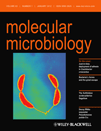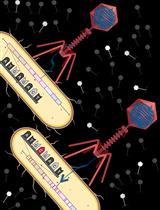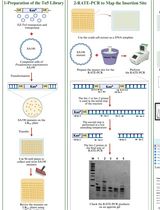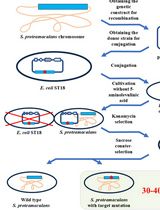- EN - English
- CN - 中文
Construction and Screening of a Transposon Insertion Library of Yersinia enterocolitica (YeO3-R1)
小肠结肠炎耶尔森菌 (YeO3-R1)转座子插入库的建立和筛选
发布: 2012年08月05日第2卷第15期 DOI: 10.21769/BioProtoc.246 浏览次数: 15059
Abstract
The Mu-transposon system is one of the best characterized transposition systems. Under minimal in vitro set-up, Mu transposition requires only a simple reaction buffer, MuA transposase protein, mini-Mu transposon DNA (donor) and target DNA. The reaction proceeds via initial assembly of the transposition complex that directs transposon integration into target DNA with high efficiency and relatively low target site selectivity. These characteristics make the Mu in vitro transposition technology ideal for the generation of comprehensive mutant DNA libraries usable in a variety of molecular biology applications. This technology has successfully been used for DNA sequencing, functional analyses of plasmid DNA and virus genomes, protein engineering for structure/function and protein-protein interaction studies and generation of gene targeting constructions. When electroporated, the in vitro–assembled Mu transposition complexes can also be used for efficient gene delivery in bacteria, yeasts and mammalian cells. Using this protocol we have identified several mutants where Cat-Mu insertion has interrupted genes involved in lipopolysaccharide (LPS) biosynthesis (Pinta et al., 2012).
Keywords: Yersinia enterocolitica (小肠结肠炎耶尔森菌)Materials and Reagents
- Yersinia enterocolitica strain YeO3-R1 (al-Hendy et al., 1992)
- Cat-Mu transposon (Haapa et al., 1999) or equivalent like Entranceposon Cam-R3 (Thermo Fisher Scientific, Finnzymes, catalog number: F-778 )
- MuA transposase 1,100 ng/μl and MuA storage buffer (Thermo Fisher Scientific, Finnzymes, catalog number: F-750C )
- 99.5% glycerol BDH (catalog number: 24388.320 )
- 10% Triton X-100 (w/v) (F. Hoffmann-La Roche, catalog number: 11332481001 )
- Ultrapure 0.5 M EDTA (pH 8.0) (Life Technologies, Invitrogen™, catalog number: 15575 )
- DTT (Sigma-Aldrich, catalog number: D0632 )
- Centricon YM-100 (100-kDa cutt off) (EMD Millipore, catalog number: UFC210024PL )
- Polyethylene glycol (PEG) 6000 (Merck KGaA, catalog number: 8.07491 )
- NuSieve 3:1 Agarose (25 g) (Lonza, catalog number: 50091 )
- Albumin from bovine serum, BSA (Sigma-Aldrich, catalog number: A7906 )
- Heparin (Sigma-Aldrich, catalog number: H3393 )
- Ficoll PM 400 (Sigma-Aldrich, catalog number: F4375 )
- Bacto-agar, Bacto-tryptone, and Bacto-yeast extract (BD DifcoTM)
- Chloramphenicol (Sigma-Aldrich, catalog number: C0378 )
- Tryptic Soya Broth (Oxoid Limited, catalog number: CM0129 )
- Enterocoliticin produced by Y. enterocolitica serotype O: 7, 8 strain 29930 (Strauch et al., 2001)
- MuA storage buffer
- Sodium acetate (NaAc)
- DNA ladder (New England Biolabs)
- Phosphate-buffered saline (PBS) (pH 7.4)
- TGD buffer (see Recipes)
- 5x complex buffer (see Recipes)
- 1 M DTT (see Recipes)
- 20% PEG6000 (w/v) – 2.5 M NaCl (5 ml) (see Recipes)
- SOB medium (1 L) without magnesium (see Recipes)
- 2 M Mg++ stock (see Recipes)
- 2 M glucose (100 ml) (see Recipes)
- SOC medium (100 ml) (see Recipes)
- Luria broth (LB) medium (1 L) (see Recipes)
- LB agar (LA) plates (1 L) (see Recipes)
- Chloramphenicol (Clm) solution (10 ml) (see Recipes)
- Tryptic soya broth (see Recipes)
- Phosphate-buffered saline (PBS) (pH 7.4) (1 L) (see Recipes)
- TAE buffer (see Recipes)
Equipment
- Centrifuges (Sorvall, Heraeus Holding)
- Water bath (Grant)
- Incubator (Termaks)
- Shaker (New Brunswick Scientific)
- Biofotometer (Eppendorf)
- Agarose gel electrophoresis (Bio-Rad Laboratories)
- Gel documentation equipment (Bio-Rad Laboratories)
- Electroporator (Bio-Rad Laboratories, Genepulser II)
- 90 mm Petri dishes (Thermo Fisher Scientific, Sterilin®, catalog number: 101RT )
- 0.1-cm electroporation cuvettes (Bio-Rad Laboratories)
Procedure
文章信息
版权信息
© 2012 The Authors; exclusive licensee Bio-protocol LLC.
如何引用
Pajunen, M., Pinta, E. and Skurnik, M. (2012). Construction and Screening of a Transposon Insertion Library of Yersinia enterocolitica (YeO3-R1). Bio-protocol 2(15): e246. DOI: 10.21769/BioProtoc.246.
分类
微生物学 > 微生物遗传学 > 诱/突变
分子生物学 > DNA > 诱/突变
系统生物学 > 基因组学 > 转座子
您对这篇实验方法有问题吗?
在此处发布您的问题,我们将邀请本文作者来回答。同时,我们会将您的问题发布到Bio-protocol Exchange,以便寻求社区成员的帮助。
Share
Bluesky
X
Copy link













